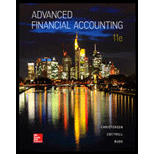
Concept explainers
Subsidiary’s shares transactions:some time subsidiary purchases treasury shares form non-controlling shareholders. The parent company may prefer not to be concerned with outside shareholders and may direct the subsidiary to reacquire any non-controlling shares that become available.
Although the parent may not participate directly when subsidiary purchases
Reciprocal ownership: A reciprocal relationship is when two companies hold stock in each other. It is rare in practice. The method of dealing with reciprocal relationships found mostly in the treasury stock method. Under treasury stock method, purchases of a parent’s stock by subsidiary are treated in the same way as if parent had repurchased its own stock and was holding it in the treasury. The subsidiary will account it as investment in parent’s stock using the cost method as such investments usually are small and almost never has the ability to significantly influence parent.
Requirement 1
Computation of book value of shares held by A and record the entry in A’s books to record the change in book value of its investment in B’s shares.
b.
Subsidiary’s shares transactions: some time subsidiary purchases treasury shares form non-controlling shareholders. The parent company may prefer not to be concerned with outside shareholders and may direct the subsidiary to reacquire any non-controlling shares that become available.
Although the parent may not participate directly when subsidiary purchases treasury stock, the parent’s equity in the net assets of the subsidiary may change as a result of the transaction. The change must be recognized in preparing the consolidated statements.
Reciprocal ownership: A reciprocal relationship is when two companies hold stock in each other. It is rare in practice. The method of dealing with reciprocal relationships found mostly in the treasury stock method. Under treasury stock method, purchases of a parent’s stock by subsidiary are treated in the same way as if parent had repurchased its own stock and was holding it in the treasury. The subsidiary will account it as investment in parent’s stock using the cost method as such investments usually are small and almost never has the ability to significantly influence parent.
Requirement 2
The Computation of book value, entries in books of B and consolidation entries in case of direct purchase from A on January 1. 20X7.
Want to see the full answer?
Check out a sample textbook solution
Chapter 9 Solutions
Advanced Financial Accounting
- Please provide the solution to this general accounting question using proper accounting principles.arrow_forwardPlease provide the solution to this general accounting question using proper accounting principles.arrow_forwardHow do milestone payments affect contract revenue recognition? a) Accrue when milestone achieved b) Recognize at contract completion c) Record when cash received d) Spread evenly over contract. MCQarrow_forward

 AccountingAccountingISBN:9781337272094Author:WARREN, Carl S., Reeve, James M., Duchac, Jonathan E.Publisher:Cengage Learning,
AccountingAccountingISBN:9781337272094Author:WARREN, Carl S., Reeve, James M., Duchac, Jonathan E.Publisher:Cengage Learning, Accounting Information SystemsAccountingISBN:9781337619202Author:Hall, James A.Publisher:Cengage Learning,
Accounting Information SystemsAccountingISBN:9781337619202Author:Hall, James A.Publisher:Cengage Learning, Horngren's Cost Accounting: A Managerial Emphasis...AccountingISBN:9780134475585Author:Srikant M. Datar, Madhav V. RajanPublisher:PEARSON
Horngren's Cost Accounting: A Managerial Emphasis...AccountingISBN:9780134475585Author:Srikant M. Datar, Madhav V. RajanPublisher:PEARSON Intermediate AccountingAccountingISBN:9781259722660Author:J. David Spiceland, Mark W. Nelson, Wayne M ThomasPublisher:McGraw-Hill Education
Intermediate AccountingAccountingISBN:9781259722660Author:J. David Spiceland, Mark W. Nelson, Wayne M ThomasPublisher:McGraw-Hill Education Financial and Managerial AccountingAccountingISBN:9781259726705Author:John J Wild, Ken W. Shaw, Barbara Chiappetta Fundamental Accounting PrinciplesPublisher:McGraw-Hill Education
Financial and Managerial AccountingAccountingISBN:9781259726705Author:John J Wild, Ken W. Shaw, Barbara Chiappetta Fundamental Accounting PrinciplesPublisher:McGraw-Hill Education





